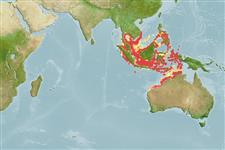Environment: milieu / climate zone / depth range / distribution range
นิเวศวิทยา
เกี่ยวกับทะเล,น้ำเค็ม สัตว์น้ำหน้าดิน; ระดับความลึก 30 - 71 m (Ref. 9824). Tropical; 14°N - 24°S, 95°E - 134°E (Ref. 9824)
Indo-West Pacific: Persian Gulf to the coast of India; north to Taiwan through the South China Sea, south to Queensland. Specimens from northern and Western Australia often treated as distinct subspecies (Ref. 9824).
ขนาด / น้ำหนัก / Age
Maturity: Lm ? range ? - ? cm
Max length : 19.0 cm TL เพศผู้/กระเทย; (Ref. 9824); common length : 7.5 cm TL เพศผู้/กระเทย; (Ref. 9824)
ก้านครีบอ่อนที่หาง (รวม) : 80 - 84; ก้านครีบอ่อนที่ก้น: 61 - 64.
Inhabits sand and mud bottoms (Ref. 9824). Feeds on bottom-living animals (Ref. 9824). Taken in shrimp trawls (Ref. 9824).
Life cycle and mating behavior
Maturities | การสืบพันธุ์ | Spawnings | Egg(s) | Fecundities | ตัวอ่อน
Kuronuma, K. and Y. Abe, 1986. Fishes of the Arabian Gulf. Kuwait Institute for Scientific Research, State of Kuwait, 356 p. (Ref. 5999)
IUCN Red List Status (Ref. 130435)
Threat to humans
Harmless
Human uses
การประมง: มีการค้าเพียงเล็กน้อย
เครื่องมือ
Special reports
Download XML
แหล่งที่มาจากอินเตอร์เน็ต
Estimates based on models
Preferred temperature (Ref.
123201): 26.2 - 28.6, mean 27.9 °C (based on 215 cells).
Phylogenetic diversity index (Ref.
82804): PD
50 = 0.5000 [Uniqueness, from 0.5 = low to 2.0 = high].
Bayesian length-weight: a=0.00912 (0.00408 - 0.02036), b=3.05 (2.87 - 3.23), in cm total length, based on LWR estimates for this (Sub)family-body shape (Ref.
93245).
ระดับชั้นอาหาร (Ref.
69278): 3.5 ±0.37 se; based on food items.
ความสามารถในการกลับคืนสู่ปกติ (Ref.
120179): ขนาดกลาง, เวลาต่ำสุดที่จะทำให้ประชากรเพิ่มขึ้นเป็น 2 เท่าใช้เวลา 1.4 - 4.4 ปี (Preliminary K or Fecundity.).
Fishing Vulnerability (Ref.
59153): Low vulnerability (10 of 100).
